Related Research Articles

The Cathach of St. Columba, known as the Cathach, is a late 6th century Insular psalter. It is the oldest surviving manuscript in Ireland, and the second oldest Latin psalter in the world.

The National Museum of Ireland is Ireland's leading museum institution, with a strong emphasis on national and some international archaeology, Irish history, Irish art, culture, and natural history. It has three branches in Dublin, the archaeology and natural history museums adjacent on Kildare Street and Merrion Square, and a newer Decorative Arts and History branch at the former Collins Barracks, and the Country Life museum in County Mayo.
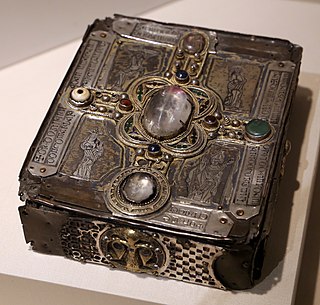
A cumdach or book shrine is an elaborate ornamented metal reliquary box or case used to hold Early Medieval Irish manuscripts or relics. They are typically later than the book they contain, often by several centuries. In most surviving examples the book comes from the peak age of Irish monasticism before 800, and the extant cumdachs date from after 1000, although it is clear the form dates from considerably earlier. The majority are of Irish origin, with most surviving examples held by the National Museum of Ireland (NMI).

Oldcroghan Man is a well-preserved Irish Iron Age bog body found in June 2003. The remains are named after Croghan Hill, north of Daingean, County Offaly, near where the body was found. The find is on display in the National Museum of Ireland in Dublin. Oldcroghan Man was found three months after a similar find, dubbed Clonycavan Man, in County Meath.
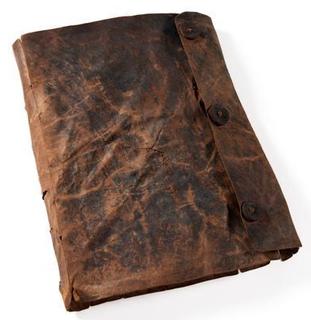
The Faddan More Psalter is an early medieval Christian psalter or text of the book of Psalms, discovered in a peat bog in July 2006, in the townland of Faddan More in north County Tipperary, Ireland. The manuscript was probably written in about 800 CE in one of a number of monasteries in the area. After several years of conservation work, the psalter went on display at the National Museum of Ireland – Archaeology in Kildare Street, Dublin in June 2011.

The prehistory of Ireland has been pieced together from archaeological evidence, which has grown at an increasing rate over the last decades. It begins with the first evidence of permanent human residence in Ireland around 10,500 BC and finishes with the start of the historical record around 400 AD. Both the beginning and end dates of the period are later than for much of Europe and all of the Near East. The prehistoric period covers the Palaeolithic, Mesolithic, Neolithic, Bronze Age and Iron Age societies of Ireland. For much of Europe, the historical record begins when the Romans invaded; as Ireland was not invaded by the Romans its historical record starts later, with the coming of Christianity.

Gallagh Man is the name given to a preserved Iron Age bog body found in County Galway, Ireland, in 1821. The remains date to c. 470–120 BC, and are of a six-foot (1.8 m) tall, healthy male with dark and reddish hair, who is estimated to have been about 25 years old at the time of death. The presence of a withy hoop – rope made from twisted willow twigs – found wrapped around his throat indicates that he was strangled during a ritual killing or executed as a criminal.
Barry Raftery was an Irish archaeologist and academic. He is best known for his pioneering work in wetland archaeology and Iron Age hillforts in Ireland. He was Professor of Celtic Archaeology in University College Dublin (UCD) for more than thirty years, and served as chair of the Department of Celtic Archeology at UCD from 1996 to his retirement in 2007.

The National Museum of Ireland – Archaeology is a branch of the National Museum of Ireland located on Kildare Street in Dublin, Ireland, that specialises in Irish and other antiquities dating from the Stone Age to the Late Middle Ages.
Cashel Man is a bog body from a bog near Cashel in County Laois, Ireland. He was found on 10 August 2011 by Bord na Móna employee Jason Phelan from Abbeyleix. The body was a young adult male, around 20–25, who had been intentionally covered with peat after death. The crouched figure was recovered after being damaged by a milling machine in 2011. The head and left arm were presumed destroyed by the peat harvester, until later recovered.
Joseph Raftery was an Irish archaeologist and director of the National Museum of Ireland.
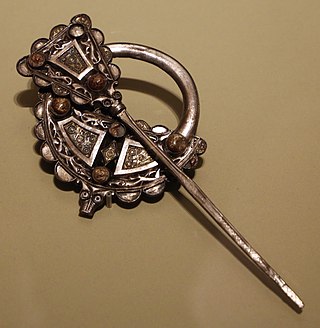
The Roscrea brooch is a 9th-century Celtic brooch of the pseudo-penannular type, found at or near Roscrea, County Tipperary, Ireland, before 1829. It is made from cast silver, and decorated with zoomorphic patterns of open-jawed animals and gilded gold filigree, and is 9.5 cm in height and 8.3 cm wide. The silver is of an unusually high quality for Irish metalwork of the period, indicating that its craftsmen were both trading materials with settled Vikings, who had first, traumatically, invaded the island in the preceding century, and had absorbed elements of the Scandinavian's imagery and metalwork techniques.

The Shrine of Miosach is an elaborately ornamented 11th-century Irish cumdach. It originates from Clonmany, north County Donegal, and is first mentioned in the 1165 Irish annals. It is dated to the late 11th century, when it probably contained a manuscript with psalms or extracts from a Gospel. However, the shrine was empty when first described in detail in the 18th century. It was originally associated with St Cairneach, patron saint of Dulane, County Meath, but by the late medieval period had become part of the cult of the abbot and missionary Colm Cille.

The Soiscél Molaisse is an Irish cumdach that originated from an 8th-century wooden core embellished in the 11th and 15th centuries with metal plates decorated in the Insular style. Until the late 18th century, the shrine held a now-lost companion text, presumed to be a small illuminated gospel book associated with Saint Laisrén mac Nad Froích, also known as Molaisse or "Mo Laisse". In the 6th century, Molaisse founded a church on Devenish Island in the southern part of Lough Erne in County Fermanagh, with which the cumdach is associated.
Raghnall Ó Floinn FSA is an Irish art historian and former director of the National Museum of Ireland (NMI), who joined its staff in 1976 and becoming its director in 2013.
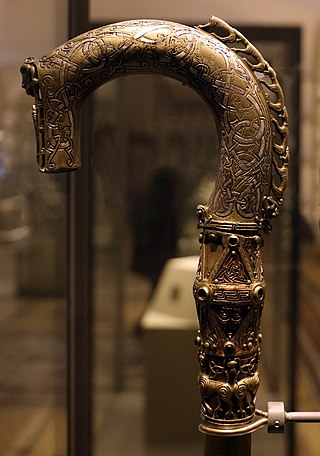
The Clonmacnoise Crozier is a late-11th-century Insular crozier that would have been used as a ceremonial staff for bishops and mitred abbots. Its origins and medieval provenance are unknown. It was likely discovered in the late 18th or early 19th century in the monastery of Clonmacnoise in County Offaly, Ireland. The crozier has two main parts: a long shaft and a curved crook. Its style reflects elements of Viking art, especially the snake-like animals in figure-of-eight patterns running on the sides of the body of the crook, and the ribbon of dog-like animals in openwork that form the crest at its top. Apart from a shortening to the staff length and the loss of some inserted gems, it is largely intact and is one of the best-preserved surviving pieces of Insular metalwork.
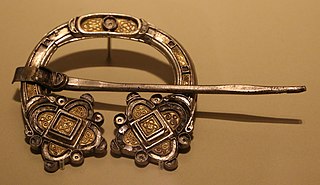
The Kilmainham Brooch is a late 8th- or early 9th-century Celtic brooch of the "penannular" type. With a diameter of 9.67 cm, it is a relatively large example, and is made from silver, gold and glass, with filigree and interlace decorations. Like other high-quality brooches of its class, it was probably intended to fasten copes and other vestments rather than for everyday wear, as its precious metal content would have made it a status symbol for its owner; less expensive Viking-style brooches were typically worn in pairs on women's clothing.

The Moylough Belt-Shrine is a highly decorated 8th-century Irish reliquary shaped in the form of a belt. It consists of four hinged bronze segments, each forming cavities that hold strips of plain leather assumed to have once been a girdle belonging to a saint and thus the intended relic. It remains the only known relic container created as a belt-shrine, although such objects are mentioned in some lives of Irish saints, where they are attributed with "remarkable cures", and there are surviving reliquary buckles in continental Europe. The belt may have been influenced by 7th-century Frankish and Burgundian types.

The Corleck Head is an Irish carved stone idol usually dated to the 1st or 2nd century AD. It was found c. 1855 in either Corleck Hill or in the nearby townland of Drumeague, County Cavan. It is carved from a single block of local limestone and shows a three-faced (tricephalic) stone idol whose faces have enigmatic and haunted expressions, with closely set eyes, a broad and rounded nose, and a simply drawn mouth. The Corleck Head was discovered c. 1855 during the course of the excavation of a large Neolithic site, along other but since lost stone heads. However it was not reported to archaeologists until 1948 after its prehistoric dating was realised by the local historian Thomas J. Barron; until then it had been placed on top of a gatepost.

The Tully Lough Cross is an 8th- or 9th-century Irish altar or processional cross, discovered by divers in 1986 at the bottom of Tully Lough, County Roscommon. Although its origin is unknown, it may be associated with a church in Kilmore, County Cavan. It is made from a wooden core covered with bronze sheets, and contains spirals derived from the Iron Age Celtic Ultimate La Tène style. Its dating is based on its use of amber and style of ornamentation.
References
- 1 2 "Eamonn P Kelly". Academia.edu. Retrieved 23 May 2021
- 1 2 Bentley (2015), p. 34
- ↑ "Genealogy at Lunchtime: Secrets of the Bog bodies". National Library of Ireland, 2006. Retrieved 23 May 2021
- 1 2 3 "Eamonn P Kelly". museum.academia.edu. Retrieved 14 August 2021